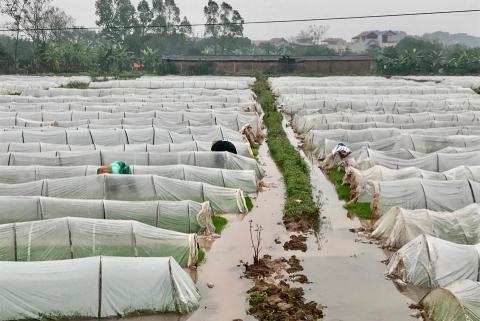Due to the developments in the weather, severe cold and prolonged harmful cold in these days are unfavorable for agricultural production in general and early spring rice crops in particular. Measures to overcome and prevent cold for seedlings and rice after transplanting need to be implemented immediately to protect seedlings and young rice from dying when exposed to cold.

Taking advantage of the warm weather conditions in the first days of January 2024, farmers took advantage of going to the fields to plant late Spring tea rice. According to the 2024 Spring crop plan, the whole province cultivates more than 35 thousand hectares, focusing mainly on 2 early Spring and Late Spring teas, of which late Spring tea has the largest area. In the last days of January 2024, the weather was in a cold, harmful cold and was estimated to last 7-10 consecutive days, with temperatures below 150 C, with some days when temperatures were below 100 C, which had a direct impact. late spring rice production progress, affecting the growth and development of seedlings and rice after transplanting.
Due to the developments in the weather, severe cold and prolonged harmful cold in these days are unfavorable for agricultural production in general and early spring rice crops in particular. Measures to overcome and prevent cold for seedlings and rice after transplanting need to be implemented immediately to protect seedlings and young rice from dying when exposed to cold. Specifically:
- Don't let Spring seedlings die because of the cold: Late Spring seedlings are focused on sowing in January 2024. In this country, basically up to now, many localities have had a large area of rice to be planted (taking advantage of the mid-season days). week of January 2024, when the temperature is warm, farmers focus on transplanting). The weather has turned cold since January 21 and the temperature has dropped to the point of severe, harmful cold. There are even days when the temperature is forecast to be below 100 C. At night, the temperature can drop even deeper and there will be severe, cold spells. The damage is forecast to last until the end of January 2024. Low temperatures mixed with light rain, gloomy weather and lack of light can easily cause the seedlings to die. Therefore, the remaining seedling areas that have not yet been transplanted need to be covered with plastic, and water should be added to cover the surface of the seedling bed to keep the feet of the seedlings warm and prevent the seedlings from freezing to death. Where conditions are close to the house and there is a power source, you can use electric bulbs to heat the plating by placing light bulbs inside the plastic dome to increase the temperature (use incandescent bulbs to generate heat, 3-5m2 used). 1 bulb with capacity of 75-100W/bulb). You can add kitchen ash and phosphate fertilizer, but absolutely do not fertilize nitrogen for seedlings.
The late spring rice transplanting season lasts until February 2024, so the seedling area needs to be protected so that when the weather warms again in February, it can be transplanted to the field. There is a plan to sow backup seeds at a rate of 5-10% with short-term rice varieties to promptly respond to weather developments.
- Protect young rice after transplanting. Currently, we are in the late Spring rice planting season, but the weather is cold and rainy, so farmers immediately stop planting rice. The planted rice areas need to keep 3-5cm of water in the field, do not let the field dry out. At low temperatures, the water in the field will keep the rice plants warm and prevent them from dying. During this time, do not apply any technical measures (no fertilization, no replanting, weeding...), keep the water level stable on the field surface to keep the feet of young rice plants warm.
After the cold spell ends, the weather gradually warms up, with temperatures above 180C, take advantage of the rice plants to quickly recover, produce young roots, new leaves and branch early:
+ Weeding to remove mud, creating airy conditions in the soil, fertilizing easily digestible phosphorus with a concentration of 5-10 kg/sao (360 m2) helps rice roots grow healthily.
+ Fertilizer to promote fertility (when rice plants produce new leaves and the temperature is warm), use a specialized mixed fertilizer such as NPK12:5:10 at 10 - 12 kg/acre or use an easy-to-digest fertilizer to ensure balance. Nutrient NPK for healthy plant growth.
+ Spray foliar fertilizers to supplement nutrients for rice plants such as: Super Phosphorus, Eco Garden,... stimulate rice plants to develop roots so that plants can absorb nutrients, creating conditions for rice plants to grow and develop. good, early and concentrated tillering.
Nguyen Dinh Trung